

© Shipping Wonders of the World 2012-

LMS Steamship Services
Since the London, Midland and Scottish Railway acquired control of numerous services between Great Britain and Ireland, as well as of certain Firth of Clyde services, many interesting paddle and screw steamers have been replaced by fine modern vessels
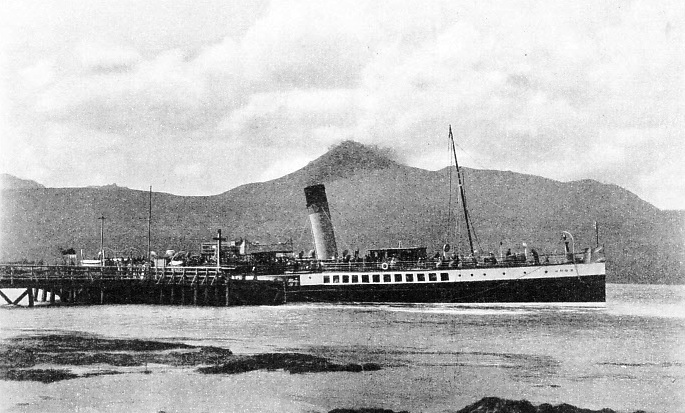
THE ISLANDS OF SCOTLAND rely chiefly upon steamship services for communication with the mainland. Above is the paddle steamer Juno, 592 tons gross, at Brodick Pier, in the mountainous island of Arran. Formerly owned by the Glasgow and South-
THE transport facilities of countries entirely sea-
At the beginning of 1936 the London, Midland and Scottish Railway owned fifty-
The first train that bore the name “The Irish Mail” left Euston Station, London, on August 1,1848, at 8.45pm. Government packets carried passengers and mails from Holyhead, North Wales, to Kingstown (Dun Laoghaire), Ireland, until 1850. At Holyhead the mails were handed over for shipment to Ireland in the paddle steamer Banshee, Caradoc, Llewellyn or St. Columba. The St. Columba was 190 feet in length, and had a beam of 27 feet. She travelled at an estimated speed of 14 knots, but the Banshee could probably make 16 knots. These speeds, as well as many details of the early packets, cannot be officially authenticated.
The mail contract for Ireland was given to the City of Dublin Steam Packet Company in May 1850. This company had been founded in 1823 and since that time had been running a number of services across the Irish Sea. In 1837 a famous paddle steamer, the Royal William, was built at Liverpool. She was the first steamer to be divided into water-
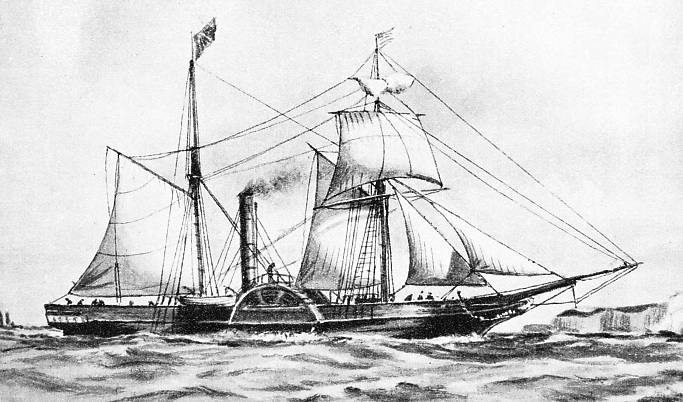
THE ATLANTIC CROSSING was made several times by the Irish cross-
A year later she was chartered by the Transatlantic Steamship Company to run between Liverpool and New York. She sailed on July 5, 1838, and thus was one of the first passenger steamers to cross the Atlantic. After a few successful crossings she returned to the Irish service and after a short period as a coal hulk she was sold in 1888. The Irish service was reorganized in October 1860. Boat trains were run from London (Euston) to connect with the four new paddle steamers Ulster, Munster, Leinster and Connaught, vessels of about 1,700 tons gross. The Connaught and the Leinster were remarkable vessels. They were schooner-
Meanwhile the Chester and Holyhead Railway (absorbed in the London and North Western in 1858), which was responsible for the Irish Mail between Chester and Holyhead, established in 1847-
In 1860 the railway steamer service was transferred from Kingstown to North Wall, Dublin. In 1863 two more vessels, the Alexandra, 828 tons gross, and the Stanley, 792 tons gross, were running on this route. Four more paddle steamers were built for this service in the next ten years.
So popular did the Irish cross-
The last paddle steamer to be built for this service was the second vessel with the name Banshee. Launched in January 1884, she was 310 feet long, with a beam of 31 ft 5-
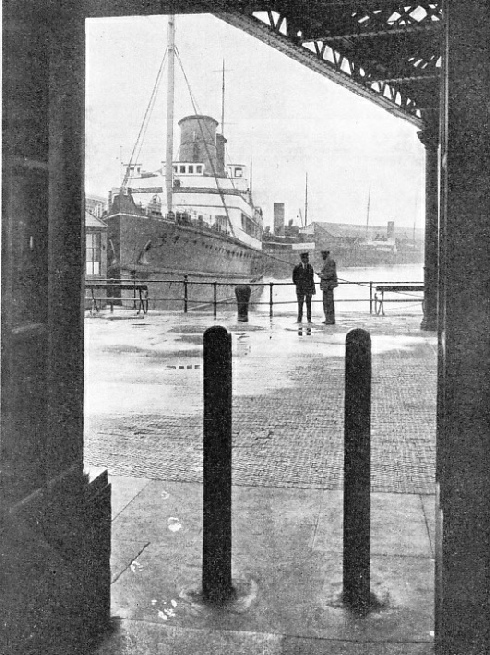 In 1920 the contract for the carriage of the Irish mails passed to the London and North Western Railway, which three years later became a constituent company of the LMS. In 1920-
In 1920 the contract for the carriage of the Irish mails passed to the London and North Western Railway, which three years later became a constituent company of the LMS. In 1920-
IN HOLYHEAD HARBOUR the Irish Mail packets await the arrival of the mail by train. This photograph shows the Scotia, 3,454 tons gross, built in 1921. She is 380 ft 6-
Ten years later three of these ships were reconditioned by the LMS and extra accommodation was provided for passengers. The vessels are certified to carry 1,505 passengers and there are sleeping berths for 308. Modern improvements were introduced throughout the vessels and the forward ends of the boat decks were covered in and fitted with large plate-
About 1853 a cargo service between Holyhead and Dublin was inaugurated with the steamships Ocean and Hercules. Later a service was established between Holyhead and Greenore, Co. Louth. These services are now maintained by LMS cargo and livestock vessels. As with its passenger ships, the LMS pursues the policy of keeping its cargo fleet up to date. The Slieve Gallion, built in 1907 by Vickers, Sons and Maxim, is a twin-
The Slieve Donard, 1,116 tons gross, carries, in addition to cargo and livestock, 134 passengers, with sleeping berths for eighteen. The Slieve More, 1,409 tons gross, was built in 1932 and was equipped with a system of protective boarding to ensure the safety of her livestock cargo. The more recent Slieve League, built in 1935, has a speed of 17 knots. She is propelled by two sets of Parsons single-
Famous Island Port
Holyhead is an interesting town. It is situated on Holy Island, which is joined to the island of Anglesey by an embankment three-
Another important mail service to Ireland was started in 1872, running from Stranraer, Wigtownshire, to Larne, Co. Antrim. The first vessel on this service was the Princess Louise, whose engines developed only 200 horse-
The first of these ships, the Princess Margaret, 2,523 tons gross, was built at Dumbarton in 1931. She has an overall length of 325 feet, a moulded beam of 47 feet and a moulded depth of 25 feet. She is driven by two sets of turbines to the main deck through single-
The building of the Princess Maud in 1934 marks an interesting development in shipping. She was one of the first British packets to be fitted at the outset with mechanical stokers. She was also the first British-
She is the larger of the two vessels, with a gross tonnage of 2,886. Her overall length is 330 feet, her beam 19 feet and her moulded depth 25 feet. She has sleeping accommodation for 223 passengers and all berths are arranged in a fore-
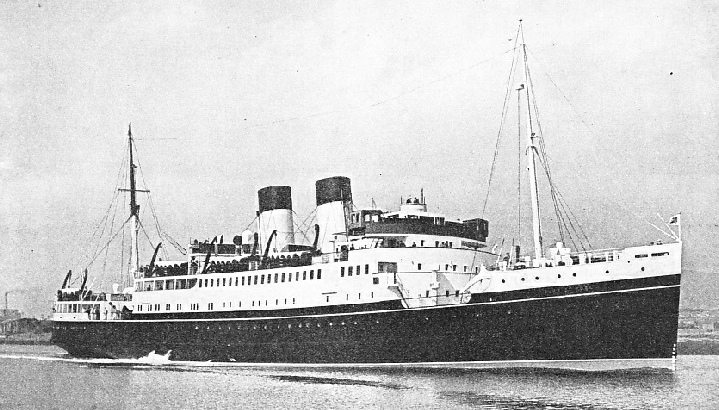
A LINER IN MINIATURE, the Duke of York, was built at Belfast in 1935 for the Heysham-
Four fine vessels were built in 1904 for the service of the Midland Railway -
On her trials the Londonderry gave a speed of more than 22 knots over a measured mile, and on service proved to be about a knot faster than the reciprocating-
Some of the largest ships of the present LMS fleet run on this service. The Duke of Lancaster was built in 1928 with her two sister ships, the Duke of Argyll and the Duke of Rothesay. Fast packets of 3,600 tons gross, they carry 1,500 passengers, with sleeping berths for 454. In addition they carry 500 tons of cargo and about 250 cattle.
Another twin-
Experiments on the Clyde
The story of the steamships that run on the Firth of Clyde forms one of the most interesting chapters in the history of British coastal shipping. The railway companies were associated with Clyde steamers as early as 1841, when the Glasgow and Greenock Railway introduced its steamers, the Isle of Bute and the Maid of Bute. On June 1, 1889, Gourock Pier (Renfrew) was opened for traffic. The Caledonian Steam Packet Company was formed and bought two vessels, the Meg Merrilees and the Madge Wildfire.
The new company prospered and built two new vessels, the Caledonia and the Galatea. The Caledonia was the first Clyde steamer to burn oil fuel, and she was fitted with a compound tandem surface-
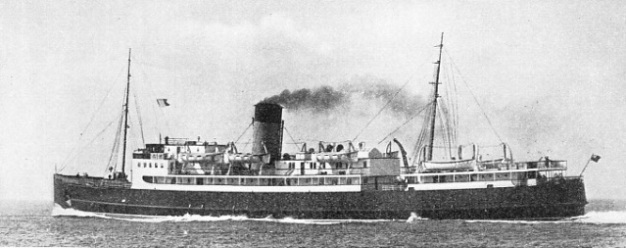
THE SHORTEST CROSSING TO IRELAND is made from Stranraer, Wigtownshire, Scotland, to Larne, Co. Antrim. This route is served by two LMS vessels, the Princess Maud and the Princess Margaret (illustrated above). A twin-
This interesting ship was in service until 1934, when she was replaced with a modern paddle-
Her sister ship, the Mercury, was also built in 1934. These two vessels, 230 feet long and 30 feet beam, were the first Clyde steamers to be built with cruiser sterns. They are propelled by side-
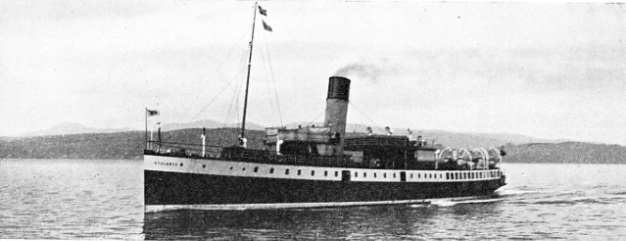
LARGE-
The turbines of the Atalanta were built as a large-
An innovation in the construction of passenger steamers appeared when, the Marchioness of Breadalbane and the Marchioness of Bute were built in 1890 at Port Glasgow. They were the first British passenger paddle steamers to have the navigating bridge forward of the funnel. This is now the common practice.
One of the early steamers built on the Clyde was the Duchess of Hamilton, built in 1890 for the Caledonian Steam Packet Company. She struck a German mine in the North Sea during the war of 1914-
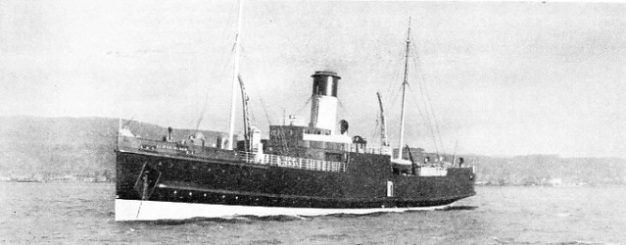
A LONDON MIDLAND AND SCOTTISH CARGO VESSEL on the Holyhead, Dublin and Greenore service, the Slieve Bloom has a gross tonnage of 1,279. Built in 1930, she has a length of 300 ft 3-
In 1935 the LMS had twelve vessels engaged on the Clyde services, five screw steamers, six paddle steamers and one small motor vessel, the Wee Cumbrae, of 37 tons gross. Gradually the old vessels are being replaced, although they are splendid and efficient boats. The fine lines of the earliest Clyde steamers compare favourably with the lines of the modern vessels.
Another addition to the extensive Clyde fleet was made in 1936 when the Marchioness of Graham was put into commission. A twin-
Similar but smaller vessels ply on Lochs Tay and Awe. The MacBrayne steamer Lochawe, 97 tons gross, formerly ran between Ford and Port Sonachan on Loch Awe. This vessel was originally a lighter, but was converted to accommodate passengers in 1876. She was working on the loch until 1925. In June 1936 a new vessel, the Countess of Breadalbane, was put into service by the LMS.
Early Lake Steamers
The first steamers on Loch Tay were the Lady of the Lake and the Sibylla, built in 1882. The Sibylla was a wooden vessel used solely for the carriage of goods. Both these vessels were broken up in 1929. The Magpie, another vessel built in the ’eighties, was wrecked and could not be salved because of the great depth of the loch. The LMS vessel now on Loch Tay is the Queen of the Lake, a twin-
In the same way the LMS diesel-
The importance of the LMS in British shipping does not rest alone on the company’s numerous and varied fleet. The LMS owns a number of docks in various parts of Great Britain, and the railway system links up most of the important docks and ports in the country. At Garston Docks, near Liverpool, more than three million tons of timber, ores, coal, fruit and general traffic are handled in the course of a year.
The harbour and docks at Barrow-
Fleetwood, Lancs, is in an excellent geographical position for the use of fishing fleets and ranks fourth in importance as a British fishing port. More than 200 fishing vessels regularly operate from Fleetwood. The largest of the steam trawlers draw about 17 ft 6-
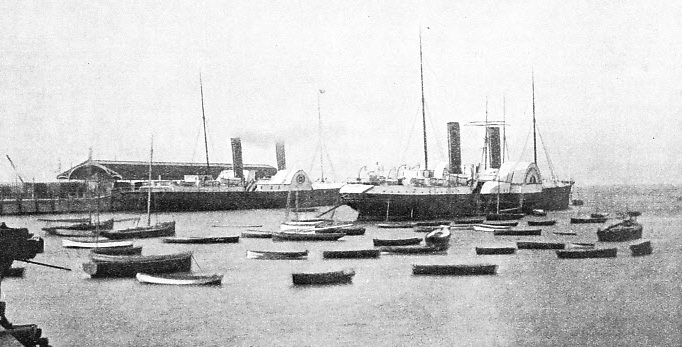
TWO FAMOUS IRISH CROSS-
Adjoining the quays of the Wyre Dock at Fleetwood is a large market where the fish can be landed direct from the trawlers. The fish is here sold, packed by the buyers and loaded directly on to the waiting fish trains. The Wyre Dock is entered through a lock 250 feet long and 50 feet wide.
The tug Wyvern is employed through the summer on a passenger service between Fleetwood and Heysham, where there is a sheltered tidal harbour of 36 acres. From Heysham, in addition to the LMS services, Burns and Laird Line steamers operate to Londonderry, Ireland, and in the summer the Isle of Man Steam Packet Company runs a daily passenger service to the Isle of Man.
In Scotland, the LMS is the Port Authority for Ayr. The harbour is formed by piers on either side of the estuary of the River Ayr. The entrance is sheltered by a breakwater. The length of quayage in the river amounts to 7,560 feet, and there is a tidal dock to the north of the harbour. Ayr is the principal outlet for the South Ayrshire coal-
The famous Forth and Clyde Canal is the property of the LMS. The canal joins the River Clyde at Bowling, ten miles west of Glasgow. Here the Company operates a small harbour and a wharf, 460 feet long, on the river. Vessels not exceeding 68½ feet in length, 19½ feet in beam and 8½ feet in draught may travel along the canal to the eastern entrance at Grangemouth, Stirlingshire.
In 1867 the former Caledonian Railway Company -
Troon Harbour and a number of piers in the Firth of Clyde are owned and operated by the LMS. In addition, the company owns more piers and quays on the west coast of Scotland. The pier at Stranraer extends 1,190 feet into Loch Ryan. The LMS owns Poplar Dock among others in the Port of London. At the East Quay of Poplar Dock vessels up to 2,000 tons load and unload cargo. From these berths steamers engage in regular services to the Continent.
A fleet of cargo vessels maintains services from the LMS port of Goole, on the River Ouse, to Copenhagen, Hamburg, Ghent, Antwerp, Rotterdam and Amsterdam. This fleet is owned by the LMS and operated by Associated Humber Lines. In 1936 there were thirteen vessels in the fleet. They range in gross tonnage from 950 to 1,108. The ships on the Copenhagen service are fitted with refrigerating plant, wireless telegraphy and direction-
The largest LMS cargo vessels on the Continental services are the sister ships Aire and Blyth, built in 1930 at Birkenhead and fitted with Oertz streamline rudders. All the ships in this fleet can carry about 1,000 tons of cargo at a speed of about 13 knots, and accommodate in addition twelve passengers.
Numerous vessels of special types are included in the tonnage owned by the LMS. Five ferry steamers, for instance, ply between Tilbury (Essex) and Gravesend (Kent). When they tie up at Tilbury, which they do quickly and methodically, they are often dwarfed by the great ocean liners alongside.
A company that owns a number of ports and docks in the British Isles must necessarily number such ancillary vessels as tugs and dredgers in its fleet. The LMS owns twenty dredgers of various types and eleven steam hopper barges. The Piel, operating at Barrow-
The LMS vessels, their funnels painted yellow with black bands at the top, are familiar in most ports on the west coast of the British Isles.
The large and varied fleet, consisting as it does of Royal Mail packets, passenger steamships, cargo and livestock-
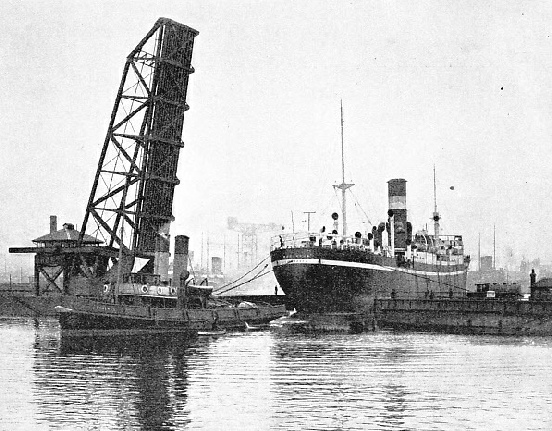
THE DOCKS AT BARROW-
You can read more on “The Canterbury”, “Dover-